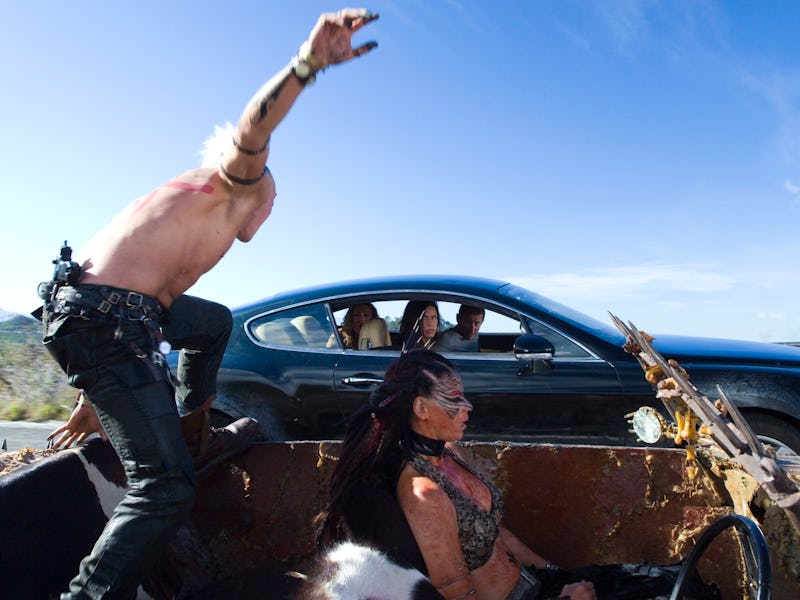Doomsday Was Neil Marshall’s First Misfire, but What a Misfire it Was
Do you wish The Last of Us had more medieval knights and Scottish cannibals?

Hailed as the new darling of the low-budget horror thanks to werewolf caper Dog Soldiers and cavernous scarefest The Descent, Neil Marshall was rewarded with a cool $25 million for his third directorial effort, Doomsday. That dwarfed his two previous budgets combined. Unfortunately, the Brit soon learned that — as a wise man once said — mo money, mo problems.
Accustomed to working in confined spaces and with a small pool of actors, Marshall suddenly found himself overseeing countless extras, multinational shoots, and spectacular set pieces inspired by Escape from New York, Mad Max, and seemingly every other post-apocalyptic blockbuster of the 1980s. It’s little wonder the filmmaker appeared overwhelmed by the sheer scale of it all.
The unapologetically derivative Doomsday takes place in 2035, 27 years after a deadly and rage-inducing virus decimated a quarantined Scotland. Having essentially doomed an entire nation via a rebuilt Hadrian’s Wall, England has since become a pariah state, one threatening to fall further into dystopia when the virus suddenly resurfaces.
After learning the country left for dead still has survivors, the British government sends Eden Sinclair (Rhona Mitra), a one-eyed security agent modeled on Kurt Russell’s Snake Plissken, and her nondescript team north of the border to find a potential cure. The Scots are understandably still angry at being ruthlessly abandoned, and although the English come in peace, a mini-civil war ensues. Marshall soon proves he’s retained his penchant for blood and gore with a frenetic first battle in which members of both factions are torn limb from limb in graphic detail. Yet it’s only here where the madness truly begins.
The cannibals enjoy a little English cuisine.
While they were previously renowned for their hospitality, the people of Glasgow are now an army of punk-rock cannibals led by a shirtless, mohawked, homicidal maniac with a pet gimp and a penchant for the can-can. Craig Conway’s Sol is such a cartoonish villain that it’s impossible to see him as much of a threat even when he’s hanging his enemies on meat hooks. And as poor Dr. Talbot (Marshall regular Sean Pertwee) discovers, this primitive community’s ideal form of entertainment is burning Englishmen alive, then tucking into them while dancing along to the most literal of 1980s pop hits (Fine Young Cannibals’ “Good Thing” and Adam and the Ants’ “Dog Eat Dog” feature prominently).
From there, it’s one insane development after another. The Prime Minister (Alexander Siddig) decides to blow his brains out rather than succumb to his fate after accidentally swallowing a rabid protestor’s blood. The surviving Brits are kidnapped by medieval knights and imprisoned in a castle owned by a mad scientist (Malcolm McDowell) before Sinclair is forced to compete in a gladiatorial battle with his chief executioner. And just in case the tone hadn’t shifted enough, there’s a high-speed car chase involving Sol’s arsenal of crazy Frankenstein vehicles and a Bentley Continental GT found deep in the Highlands.
Rhona Mitra in familiar ass-kicking mode.
Marshall seemed aware that such outlandish scenes would divide audiences, admitting he wanted to bombard them with so much imagery they’d need a second viewing to take it all in. But it seems unlikely that many who enjoyed the more streamlined joys of his early work flocked back to the cinemas.
Instead, the gonzo editing, muddled narrative, and gaping plot holes mean you could sit through a dozen screenings and still be none the wiser about what’s going on. Doomsday often looks terrific, although the South African location shoot never quite convinces as Scotland. But it fails to tie its warped action sequences together with any sense of cohesion.
And although Mitra — no stranger to playing the gun-toting heroine — gets to shed a tear upon discovering the fate of her long-lost mother, the rest of the cast are denied any emotional weight. Even the late Bob Hoskins struggles to make his mark with the thankless role of Sinclair’s bulldog boss. Marshall made us care about who made it out of Dog Soldiers’ rural cabin and The Descent’s monster-filled cave. But Doomsday’s characters always play second fiddle to all the beheadings and burnings.
Sol and his team on the hunt for more hair dye.
Marshall’s hell-for-leather approach didn’t pay off at the box office, grossing just $22.5 million, less than half of The Descent’s tally. And although it put the issue of Scottish independence on the global map, the Scottish National Party wasn’t particularly enthusiastic either, with one member bemoaning the depiction of a nation “that is still the plaything of London.”
Unsurprisingly, Doomsday didn’t get the sequel it blatantly sets up when Sinclair turns her back on London to become the marauders’ new leader. But you do have to give some props to Marshall for living out his fantasies with such wild abandon; you could certainly never accuse the film of holding back. He’d later prove he could handle more expansive fare by helming well-received episodes of Game of Thrones and Westworld (the less said about Hellboy, the better), but his first experience with the big bucks was undoubtedly a case of too much, too soon.
This article was originally published on